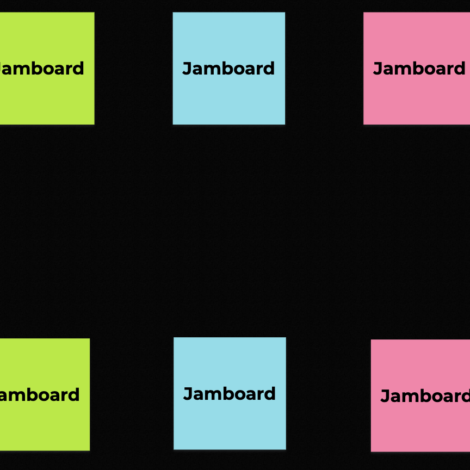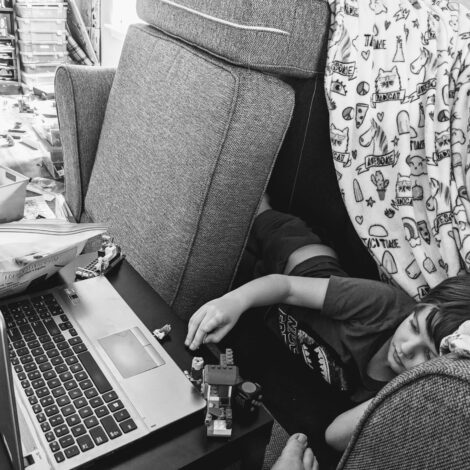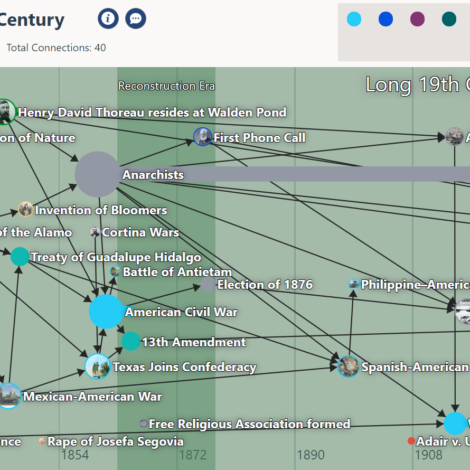Very quickly it became clear that the virtual classroom operated a bit more clunkily than an in-person class. Classes were missing the chatter or just the noises of people inhabiting a room together that precede in-person classes. I love starting each semester with a silly icebreaker, and this fall was no different. I asked students if they shrunk down to the size of AntMan, what insect would they want to ride and why? Answers ranged from terrifying bugs to scare off predators to riding monarchs to see the world during their migration. In both my undergrad and grad classes, students
Jamboards: Collaborating Together Online
After a long time away (and the year of all years), I’m happy to reenter this space to reflect a bit on some of the teaching tips and tricks that have gotten me through this past year, and especially on those that will continue to be useful after we’ve returned back to in-person teaching (or some type of hybrid teaching). One of my favorite tools I’ve adopted this year is Google’s Jamboard. Jamboard provides a collaborative digital whiteboard platform, with tools to add sticky notes, text, images, and free-form drawing. It’s free to use, and just requires a Google account
Brain Breaks and Birdhouses: What I Learned from 1st-2nd Grade Virtual Maker Camp
If you asked me six months ago how I envisioned summer break, I’d probably have told you about swimming at pools and lakes, hanging out with my kids, and, best of all, the days my kids would be spending together at summer camp. Thanks to #covid19, most of that isn’t happening. Instead, my 7-year-old has been doing a virtual KSU iTeach Makercamp this summer, and he’s had fun making things like birdcages and musical instruments and robot claws (and 2yo has had fun building his own versions too). So what can we learn from a virtual summer camp for kids
Seven Great Resources for Moving Your Class Online
I’ve written a couple posts about keeping it simple and thinking about equity as we move our higher ed classes online due to COVID-19 closures. But I wanted to take a few minutes to share a few of my favorite resources I’ve found that I think are great for helping consider the logistics, ethics, and pedagogy of moving courses online. I’ll list a few of my key takeaways from each “Your Suddenly Online Class Could Actually Be a Relief” by Alexandra L. Milsom use as few tools as possible and go easy on yourself maintain community as best you can
Keep it simple, y’all – moving your class online
As we all face down the likelihood of moving courses online this semester for the covid-19 outbreak, it’s easy to get caught up in the overwhelm of hundreds of pedagogical options and the glitter of new tech tools. Our passion for teaching drives us to constantly innovate, to make our classes better and more engaging. After all, Pedagogy Playground is born of this impulse. But truly innovative, engaging online classes take weeks or even months to develop, and we don’t have the luxury of that right now. On top of the time crunch (and for many of us still, the
An Equitable Transition to Online Learning – Flexibility, Low Bandwidth, Cell Phones, and more
Discussions about temporarily converting our face-to-face courses to an online environment have been circling both my university and the larger academic community in the past few weeks. As large institutions like UW, Stanford, and Princeton prepare to make these shifts, it’s likely to expect that other colleges and universities will follow suit. The first suggestions I heard for this shift were those of operating a large lecture or discussion class via Zoom, synchronous with the time the class usually would have met. Foremost on mind then have been questions of equity. What if some students (or faculty) don’t have access
Thinking Critically with ClioVis
ClioVis creator, Dr. Erika Bsumek, an associate professor at UT-Austin, recently joined us on campus to lead a workshop on using ClioVis, an interactive digital timeline tool. Like TimelineJS and other digital timeline tools, you can plot points on a timeline, create summaries of those items, and attach images to them. ClioVis goes above and beyond these other tools in a few big ways: it’s much more interactive and allows users to create connections between items the interface is very easy to use it’s easy for students to collaborate in groups. It’s clear that Bsumek is passionate about pedagogy and
Jigsawing: Piecing the Story Together
This has to be my alllll-time favorite teaching method. There’s just something about it that gets students engaged in conversation, and they always get super animated in teaching their peers and giving detailed examples. With this method, groups of students each read a different section / chapter. They group together in class first with those who read the same thing as them and unpack the reading, and then they’re divided up to teach their peers in groups. This can be modified in lots of ways (students can read / prep in class, etc.), but we’ll start with a basic approach.
Becoming Better Notetakers
I remember early in my Ph.D. program I was frustrated with a dissertation chapter I was writing. I went with my intuition and produced a giant concept map of what I wanted to say. I finished the diagram with a sigh of relief — the chapter made sense now. But I still felt guilty like I was doing something wrong. Real writers didn’t use concept maps, right? I’m not sure anyone ever taught me how to take notes productively, certainly not after elementary/middle school, and I still struggle with notetaking today. I’m a chronic over-highlighter, and I have a hard











